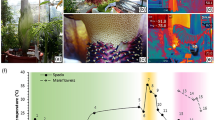Abstract
A device has been developed for determining the influence of temperature, irradiance and relative air humidity on the emission of flower volatiles in situ. The compounds emitted from flowers of Trifolium repens L. are mainly products of cinnamic-acid metabolism. Phenethyl acetate was the dominant compound in the fragrance picture. Additionally, a number of sesquiterpenes were identified in the emissions. All compounds were emitted in a rhythmic manner with a maximum at 7–12 h after the light is switched on. Temperature had a strong effect on the the quantity of fragrance in the headspace. Emission at 10°C was significantly lower than at 15°C and 20°C. This difference can be attributed to a temperature effect on the secretion of volatiles rather than on the evaporation rate of volatiles. Light influenced fragrance emission significantly, the most intense emission being noted at high irradiances. No effect of relative humidity on fragrance emission could be detected. The composition of the fragrance picture was not influenced by the climatic factors. Emission was controlled by the light and dark intervals rather than by the endogenous clock.
Similar content being viewed by others
References
Altenburger, R., Matile, P. (1988) Circadian rhythmicity of fragrance emission in flowers of Hoya carnosa R. Br. Planta 174, 248–252
Altenburger, R., Matile, P. (1990) Further observations on rhythmic emission of fragrance in flowers. Planta 180, 194–197
Brantjes, N.M.B. (1978) Sensory responses to flowers in night-flying moths. In: The pollination of flowers by insects (Linnean Soc. Symp. Ser. 6), pp. 13–19, Richards, A.J., ed. Academic Press, London
Büdel, A. (1959) Das Mikroklima der Blüte in Bodennähe. Z. Bienenforsch. 4, 131–140
Dobson, H.E.M., Bergström, J., Bergström, G., Groth, I. (1987) Pollen and flower volatiles in two Rosa species. Phytochemistry 26, 3171–3173
Dobson, H.E.M., Bergström, G., Groth, I. (1990) Differences in fragrance chemistry between flower parts of Rosa rugosa Thunb. (Rosaceae). Israel J. Bot. 39, 143–156
Free, J.B., Williams, I.H. (1983) Scent-marking of flowers by honeybees. J. Apic. Res. 22, 86–90
Fægri, K., van der Pijl, L. (1980) The principles of pollination Biology. Pergamon Press, Oxford
Giurfa, M, Núñez, J.A. (1992) Honeybees mark with scent and reject recently visited flowers. Oecologia 89, 113–117
Heinrich, B. (1979) Bumblebee economics. Haward University Press, Cambridge Massachusetts London
Honkanen, E., Moisio, T., Karvonen, P. (1969) Studies on the volatile flavour substances in some clover species. Suomen Kemistilehti 42, 448–451
Howell, D.J. (1977) Time sharing and body partitioning in bat-plant pollination systems. Nature 270, 509–510
Jones, M.B., Mansfield, T.A. (1975) Circadian rhythms in plants. Sci. Prog. Oxf. 62, 103–125
Kameoka, H., Wang, C.-P., Tokimitsu, K. (1977) Terpenoids in the essential oil from the flower of Trifolium repens L. Agric. Biol. Chem. 41, 1785–1786
Knudsen J.T., Tollsten, L. (1991) Floral scent and intrafloral scent differentiation in Moneses and Pyrola (Pyrolaceae). Plant Syst. Evol. 177, 81–91
Levin, D.A. (1973) The role of trichomes in plant defence. Quart. Rev. Biol. 48, 3–15
Loughrin, J.H., Hamilton-Kemp, T.R., Andersen, R.A., Hildebrand, D.F. (1990) Volatiles from flowers of Nicotina sylvestris, N. otophora and Malus x Domestica: Headspace components and day/night changes in their relative concentrations. Phytochemistry 29, 2473–2477
Loughrin, J.H., Hamilton-Kemp, T.R., Andersen, R.A., Hildebrand, D.F. (1991) Circadian rhythm of volatile emission from flowers of Nicotina sylvestris and N. suaveolens. Physiol. Plant. 83, 492–496
Lumer, C. (1980) Blakea chlorantha (Melastomaceae): A rodent pollinated plant in the neotropics. Bot. Soc. Am. Misc. Ser. Publ. 158, 68
McGregor, S.E. (1976) Insect pollination of cultivated crop plants. Agriculture Handbook No. 496. Agricultural Research Service. United States Department of Agriculture, Washington, D.C.
Matile, P., Altenburger, R. (1988) Rhythms of fragrance emission in flowers. Planta 174, 242–247
Metcalf, R.L. (1987) Plant volatiles as insect attractants. Crit. Rev. Plant Sci. 5, 251–301
Mookherjee, B.D., Trenkle, R,W., Wilson, R.A., Zampino, M., Sands, K.P., Mussinan, C.J. (1986) Fruits and flowers: Live vs dead — which do we want. In: A world perspective. Proc. 10th Int. Congress of essential oils, fragrances and flavors, Washington, USA
Pellmyr, O., Thien, B.T. (1986) Insect reproduction and floral fragrances: Keys to the evolution of the Angiosperms. Taxon 35, 76–85
Robacker, D.C., Flottum, P.K., Sammantaro, D., Erickson, E.H. (1983) Effects of climatic and edaphic factors on soybean flowers and the subsequent attractiveness of the plant to honey bees. Field Crop Res. 6, 267–278
Robacker, C.R., Meeuse, B.J.D., Erickson, E.H. (1988) Floral aroma. How far will plants go to attract pollinators. Bioscience 38, 390–398
Rodriguez, E., Levin, D.A. (1976) Biochemical parallelisms of repellants and attractants in higher plants and arthropods. In: Recent Adv. Phytochem. 10, 214–270
Wetherwax, P.B. (1986) Why do honeybees reject certain flowers. Oecologica 69, 567–570
Wilhelm, K.T., Pflumm, W. (1983) Über den Einfluss blumenhafter Düfte auf das Duftmarkieren der Sammelbiene. Apidologie 14, 183–190
Williams, N.H. (1982) The biology of orchids and euglossine bees. In: Orchid biology, reviews and perspectives II, pp. 119–171, Arditti, J., ed. Cornell University Press, Ithaca London
Wood, D.L. (1982) The role of pheromones, kairomones and allomones in the host selection and colonization behavior of bark beetles. Annu. Rev. Entomol. 27, 411–446
Author information
Authors and Affiliations
Additional information
The authors wish to thank Mette Sørensen and Niels Midtgaard for technical assistance. Thanks to Hugo Fritzen from Danish Plant Breeding Ltd, St. Heddinge, Denmark, for providing plant material. We are grateful to P. Friis, Chemistry Department, H. Martens, Department of Plant Biology, both The Royal Veterinary and Agricultural University, Copenhagen, Denmark, for constructive criticism and to P. Lakos for editorial assistance. The research was supported by the Danish Agricultural and Veterinary Research Council (Grant no. 13-4178 and 13-4580-1), The Danish Seed Testing Board and Stiftelsen Hofmansgave.
Rights and permissions
About this article
Cite this article
Jakobsen, H.B., Olsen, C.E. Influence of climatic factors on emission of flower volatiles in situ. Planta 192, 365–371 (1994). https://doi.org/10.1007/BF00198572
Received:
Accepted:
Issue Date:
DOI: https://doi.org/10.1007/BF00198572




